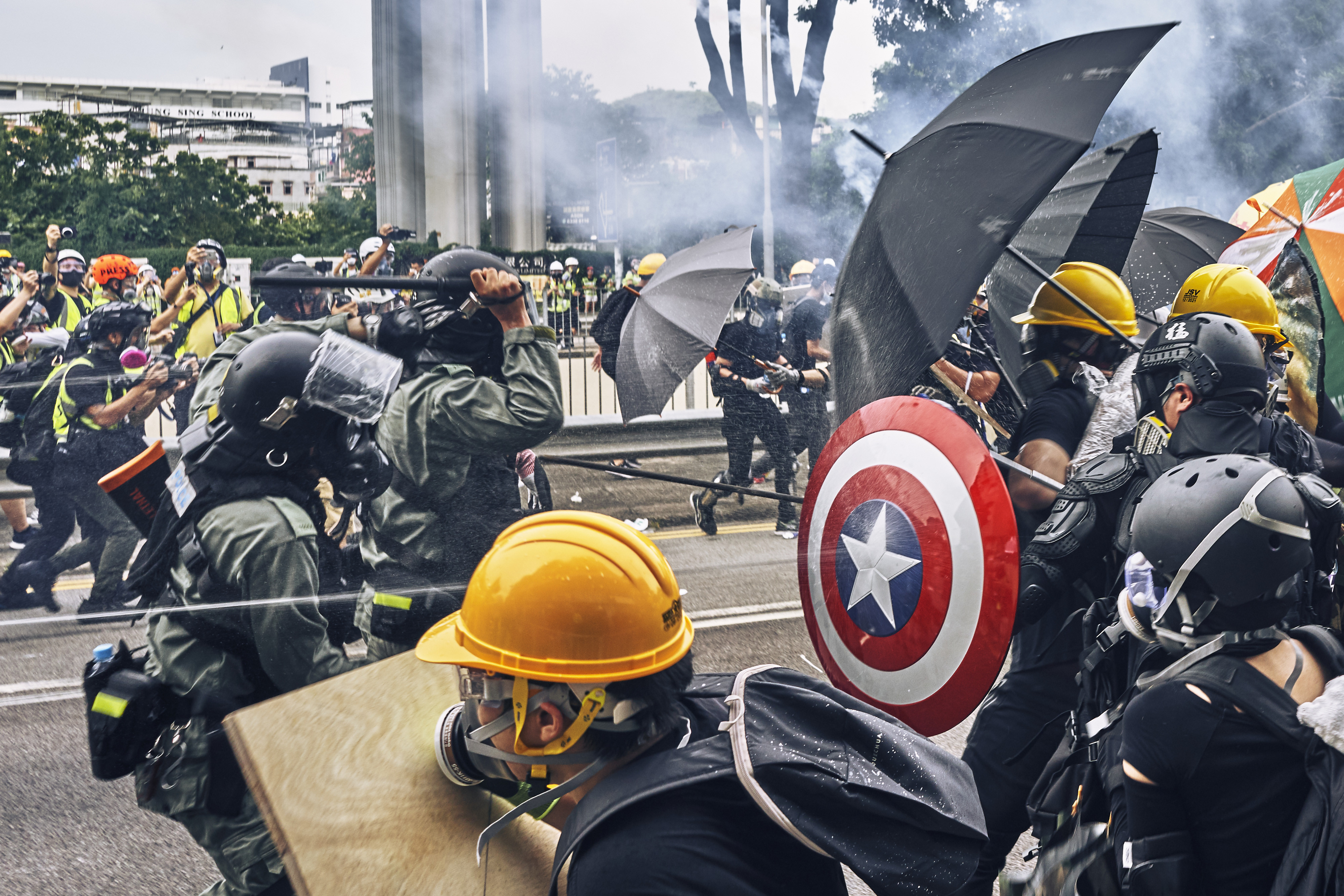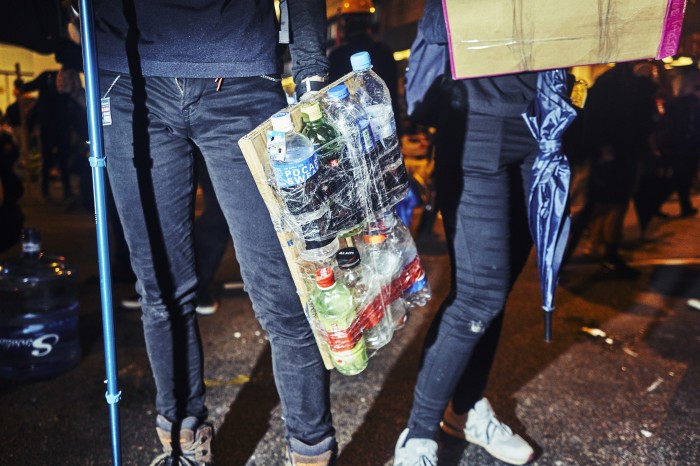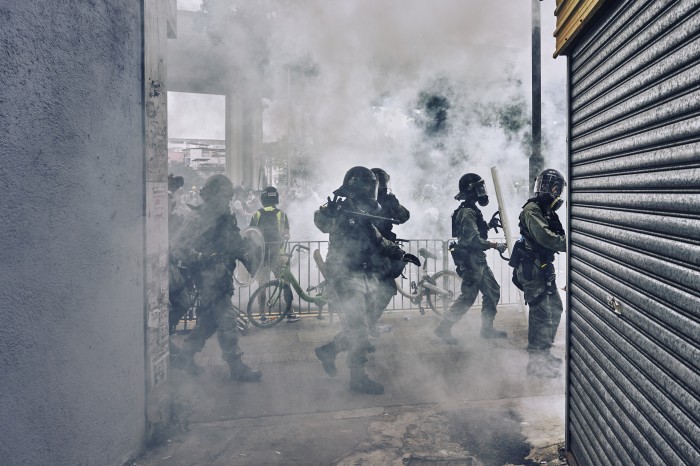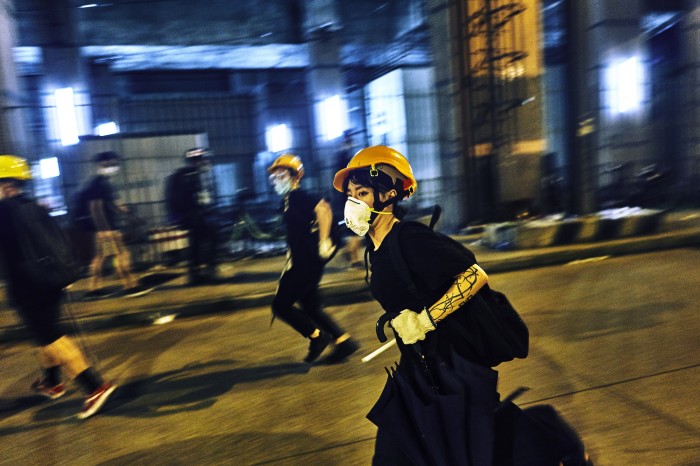The new battle in Hong Kong isn’t on the streets; it’s in the apps

Alice had been marching for hours by the time she got home on the evening of July 21. It was a Sunday, and the sweltering heat of a Hong Kong summer had left her exhausted and jittery. Still, she was transfixed by her phone, which had been buzzing the entire subway ride.
It was pinging with news alerts about a group of protesters who had split from the peaceful procession and were facing off against riot police. On arriving at her apartment, she opened her laptop and fired up a website that displayed a dizzying nine separate live shots from different news outlets. One stream in particular caught her eye, showing chaos at a nearby railway station. She could see men armed with clubs who were terrorizing train passengers, bursting into subway cars and bludgeoning bystanders who were kneeling on the floor begging for mercy.
The live stream was gripping and horrifying: Alice felt as if she were in the middle of the station. She flinched and screamed when an attacker in a pink shirt hit a reporter who was filming from her cell phone. Despite being beaten to the floor by the blows, the journalist kept on filming and narrating the scene as she got back on her feet. When the police arrived, Alice saw passengers screaming at them for turning up only when the violence was over. The crowd’s anger swelled, and the officers eventually retreated.
“I know I wasn’t there,” Alice, who asked to be identified only by the English name she uses because of fears for her safety, told me recently. “But the experience was deeply visceral. I could feel the mood and the tension in the station, of how angry everyone was at the police in real time. There were moments where it felt like the police would also start beating people. And the reporter narrating, shouting questions … she sounded like she could be me.”
Information, streamed
Hong Kong is famous for its souk-like electronics malls, and it’s blanketed with high-speed internet. So when protests broke out in June over plans to implement a controversial extradition law—which would see Hong Kongers accused of crimes turned over to mainland China’s notoriously opaque justice system—it was natural that many people turned to online services for more information and guidance.
Some of these methods have already been heavily documented. Everything from supplies of food and water to press conferences are put together in the chat app Telegram, for example. Meanwhile, LIHKG, a Reddit-like forum that is limited to local ISPs, provides a sandbox of ideas where a network of anonymous citizens can exchange memes, protest schedules, and tactics. Online polls often dictate the location of the next traffic-disrupting flash mob.
"The audience doesn’t want well-packaged shot—they want to feel what it’s like to be on the ground, in the most dangerous situation."
And, as in many protests in the past, a small army of journalists and activists have been live-streaming everything from major marches to minor spats with police. The raw videos tap into local media habits—many people leave live streams playing in the background while they cook dinner or hang out with friends—and help create a sense of solidarity and belonging, even among those who are not on the streets themselves.

(Some even watch live streams while they are attending protests: At one recent demonstration, an elderly man watched a video feed showing a group about 50 yards away. As they sang a rhyme taunting police, it echoed a moment later on his cell phone.)
Gwyneth Ho, the reporter for Stand News who was attacked for holding the camera that Alice was watching that night, says it creates a very direct connection for many viewers.
“We disregard quality and framing, but we’re in the middle of the protesters and even the police, and people get really immersed in the scene,” she says. “The audience doesn’t want well-packaged shots—they want to feel what it’s like to be on the ground, in the most dangerous situation.”
She adds, “A lot of people have told me it was like a VR experience of getting beaten.”

Real time
Video footage has been important to protest movements many times before, of course, and social media and online messaging have been influential elsewhere as well—including the Arab Spring protests that spread around the Middle East and North Africa in the early 2010s. But Hong Kong has developed some of its own techniques, too.
Several teams of volunteers have started constructing and sharing live maps to help those on the ground during demonstrations. They’re the brainchild of a man who goes by Orca, an educator in his 40s. He was spurred into action after seeing “massive panic and lots of anxiety” during one protest that gave rise to clashes in a high-end shopping mall (“No one knew where the police were or how they could get to an escape route,” he told me. “So our team began planning to map out the next big rally the following week.”)
Now Orca and his team publish dozens of maps during large demonstrations, updating positions with colors to show the location of police, “thugs,” and protesters, plus icons to signify first aid, rest, and supply stations. All of this is put together by on-the-ground volunteers who draw the information out on a blank map on their iPads, and send it to an “integrator” who compares the data with news from live streams and television stations before putting it all together and sending it out over Telegram or Apple’s AirDrop file transfer service. During one rally, an estimated 600,000 people downloaded maps put out by Orca’s team, just one of three mapping services created during the protests.
Alice—who has used Orca’s maps on several occasions—never thought her involvement would extend beyond the occasional march. But something changed after she watched the subway rampage.

In the days that followed, she spent her daily commute AirDropping protest art and information about the attack to anyone with an open connection. A week later she marched in her first unauthorized assembly, in the suburb where the train attacks unfolded.
She began donating the little money she could spare to an online fund-raiser helping pay arrested protesters’ legal fees, and after being tear-gassed by police herself, she donated boxes of gas mask filters. She would leave spare change on top of subway ticket machines, allowing protesters to buy single-use tickets to avoid being tracked.
Then, three weeks after she watched the train station attack, Alice decided her contributions needed to become more direct. During one of the most violent weekends so far, she joined the crowd, carrying a rucksack filled with supplies: bandages, water, snacks, and filters for gas masks. When she saw a call on Telegram, she rushed forward toward police lines for the first time, opened her bag to those in need, and quickly retreated, checking Orca’s maps to avoid running into police.
New battlegrounds
On August 24, Alice looked over a crowd of demonstrators gathered around one of the 50 smart lampposts that had been installed around the city since June. Each one—and another 350 are on order—is stuffed with cameras and surveillance equipment. Posts on Telegram had told her about the action that was set to unfold, and she watched as other activists took power tools to its base.
Alice could no longer call herself a passive participant. She was dressed in what has become the uniform among demonstrators: black from head to toe, her face obscured by a black surgical mask and a black baseball cap.
The towering metal pole fell with a loud clunk, and the crowd erupted in cheers. Protesters immediately descended on the lamppost and began pulling out components, photographing manufacturer and component details and uploading the information. Demosisto, a pro-democracy political party, published a quick analysis of each component.
"This moment is our last chance to fight for Hong Kong, or the next generation won’t even know what privacy is."
Lokman Tsui, an assistant professor at the Chinese University of Hong Kong and the former head of free expression in Asia at Google, says that while technology has been crucial in building support for the movement, many have shifted the focus of their efforts to outsmart the government. “In the past few months people have educated themselves incredibly quickly on end-to-end encryption, only buying single-use transit cards, and the dangers of widespread surveillance,” he says.
Police have arrested over 1,100 people in the last three months and have become increasingly aggressive in their tactics. Protesters are worried, and their behavior—from attacking CCTV cameras by spray-painting them or smashing them with metal poles to finding ways to avoid communicating with each other over unencrypted services—reflects their reaction to this situation.

Tsui coauthored a paper this year showing how many types of data Hong Kong’s telecommunications companies do not consider to be personal and protected, including a user’s geolocation and IP addresses, as well as the information on websites visited. This interpretation, which was made privately by the companies themselves and has not been challenged in court, means that police do not need a warrant to request, say, a list of subscribers who were in a certain place at a certain time. Information collected by Hong Kong authorities could also be handed over to China, Tsui added, since there is no formal agreement defining what can and cannot be shared.
Protesters have become so wary of sharing any identifying information that no one directly involved in the protests agreed to be identified by name. Orca would only conduct an interview over Telegram; Alice asked she be referred to by her English name, which is not on her official ID card.
Alice does not even know the real names of several friends she’s made at the protests. When they message on Telegram, they use their aliases—all English pseudonyms. Even though they are anonymous, anyone who is arrested is cut out of the group for fear that police could compromise their phones.
Five demands
Carrie Lam, Hong Kong’s chief executive, recently announced she planned to formally withdraw the extradition bill, meeting one of the protesters’ five key demands. (Their other requests: Lam’s departure, democratic elections, an independent investigation into police actions, and amnesty for those already arrested.)
But the move seems unlikely to placate the public.
Protests continue, with privacy issues and the police—who have faced many allegations about excessive use of force—now the focus of anger. The mood was felt almost immediately after Lam’s announcement, not in people taking to the streets but in online posts echoing a popular protest chant: “Five demands, not one less.”
With no end in sight, Lam has considered invoking emergency powers, according to local media. One of her first targets would likely be the apps that protesters use to organize. The mere suggestion was so divisive that members of Lam’s cabinet warned her against the move, and the Hong Kong Internet Service Providers Association declared that “any such restrictions, however slight originally, would start the end of the open Internet of Hong Kong.”

The Chinese government’s concern is that the internet is also the most likely way the Hong Kong protests could spread to the rest of the country. This scenario terrifies Chinese leaders: strict censorship rules have been issued, and border guards regularly check the phones of people traveling from Hong Kong for any sign of protest photos or videos. After Lam’s announcement that she would withdraw the extradition bill, posts on Chinese social media wondered why those elsewhere in China face jail time for even a hint of dissent. The messages quickly disappeared, and search results were replaced with a message warning that the query “does not comply with relevant regulations.”
But amid attempts by the Chinese government to deter protesters by releasing viral clips on Twitter threatening a military crackdown, there is little sign Hong Kongers are cowed. Alice feels that their collective efforts are leveling the playing field between the government and demonstrators.
“When the government lies to the people every week, every day, we cannot trust their promises or that they will follow the law,” she says. “This moment is our last chance to fight for Hong Kong, or the next generation won’t even know what privacy is.
“The government uses an old playbook, but we have created whole new ways of resisting. And if we didn’t stand up and [we] let Hong Kong become just another Chinese city, all that creativity would be snuffed out.”
Deep Dive
Humans and technology
Building a more reliable supply chain
Rapidly advancing technologies are building the modern supply chain, making transparent, collaborative, and data-driven systems a reality.
Building a data-driven health-care ecosystem
Harnessing data to improve the equity, affordability, and quality of the health care system.
Let’s not make the same mistakes with AI that we made with social media
Social media’s unregulated evolution over the past decade holds a lot of lessons that apply directly to AI companies and technologies.
Stay connected
Get the latest updates from
MIT Technology Review
Discover special offers, top stories, upcoming events, and more.